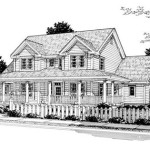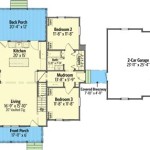```html
House Plans For Florida Living
Florida's unique climate and lifestyle preferences necessitate specialized house plans that prioritize comfort, durability, and energy efficiency. Designing a home suitable for Florida living involves considering factors such as hurricane resistance, heat mitigation, flood zones, and the desire for seamless indoor-outdoor transitions. This article will explore key elements of house plans tailored for the Florida environment, focusing on design considerations, structural adaptations, and popular architectural styles.
Adapting to Florida's Climate: Key Design Considerations
Florida's climate presents significant challenges for homeowners. High temperatures, humidity, intense sun, and frequent rainfall require careful planning during the design phase. Orientation of the house on the lot is crucial to minimize solar heat gain. Ideally, the longest side of the house should face north and south, reducing direct sun exposure on the east and west walls, which are most susceptible to overheating. Overhangs, awnings, and strategically planted trees can further shade windows and walls, reducing the need for air conditioning.
Ventilation is another vital aspect of Florida house plans. Natural ventilation, achieved through strategically placed windows and screened porches, allows for airflow that helps to cool the home and reduce humidity. Cross-ventilation, where air can flow freely from one side of the house to the other, is particularly effective. In addition to natural ventilation, mechanical ventilation systems, such as whole-house fans or energy recovery ventilators (ERVs), can improve indoor air quality and reduce energy consumption.
Material selection plays a pivotal role in mitigating the effects of Florida's climate. Light-colored roofing materials reflect sunlight, reducing heat absorption. Impact-resistant windows and doors protect against hurricane-force winds and flying debris. Exterior walls constructed from concrete block (CMU) or insulated concrete forms (ICF) offer superior thermal performance and structural integrity. Durable siding materials, such as fiber cement or vinyl, resist moisture and insect damage. Consider using materials with low volatile organic compound (VOC) emissions for improved indoor air quality.
Elevating the house above the base flood elevation (BFE) is often necessary in coastal areas and flood zones. This protects the home from flood damage and reduces flood insurance premiums. Elevating the house can also provide space for parking or storage underneath. Proper drainage is essential to prevent water from pooling around the foundation. This can be achieved through grading the yard away from the house, installing French drains, or incorporating a swale to redirect water flow.
Structural Adaptations for Hurricane Resistance
Hurricane-resistant design is a fundamental aspect of Florida house plans. Building codes in Florida are stringent regarding wind resistance and structural integrity. These codes are designed to protect homes from the devastating effects of hurricanes. Meeting or exceeding these codes is essential for ensuring the safety and longevity of the home.
Roofing systems are particularly vulnerable to hurricane-force winds. Roofing materials must be securely fastened to the roof deck to prevent them from being blown off. Using hurricane straps or clips to connect the roof rafters or trusses to the wall studs significantly increases the roof's resistance to uplift forces. Adhering to the latest Florida Building Code requirements for roofing is critical.
Impact-resistant windows and doors are essential for protecting the home from windborne debris. These windows and doors are designed to withstand the impact of objects such as tree limbs and flying debris. They are made with laminated glass or polycarbonate materials that prevent shattering and maintain the integrity of the building envelope. In areas prone to particularly strong winds, installing hurricane shutters or reinforced window films may be necessary.
Reinforcing the structural frame of the house is crucial for withstanding hurricane-force winds. This includes using reinforced concrete block (CMU) walls, reinforced concrete columns and beams, and properly designed connections between the roof, walls, and foundation. Continuous load path connections ensure that wind loads are transferred from the roof to the foundation without causing structural failure. Using tie-down straps to secure the walls to the foundation is also essential.
Garage doors are often a weak point in a home's structural integrity during a hurricane. Upgrading to a hurricane-rated garage door or reinforcing the existing door with bracing can significantly reduce the risk of damage. The garage door should be able to withstand high wind pressures and impacts from debris. Consider installing a garage door that meets or exceeds the requirements of the Florida Building Code.
Popular Architectural Styles Suited for Florida Living
Several architectural styles are well-suited for Florida living, each offering a unique aesthetic appeal and functional advantages. These styles often incorporate features that enhance comfort, promote energy efficiency, and celebrate the indoor-outdoor lifestyle.
The Coastal style is a popular choice for Florida homes, characterized by light and airy spaces, large windows, and expansive porches. This style often features light-colored exteriors, such as white or pastel shades, and natural materials like wood and stone. The open floor plans promote ventilation and maximize views of the surrounding landscape. Coastal homes often incorporate raised foundations to protect against flooding and provide ample outdoor living space.
The Mediterranean style is another classic choice for Florida homes, drawing inspiration from the architecture of the Mediterranean region. This style features stucco exteriors, tile roofs, arched doorways, and courtyards. The thick walls provide excellent insulation, helping to keep the home cool in the summer. Mediterranean homes often incorporate fountains, gardens, and outdoor kitchens, creating a luxurious and inviting atmosphere.
The Florida Ranch style is a single-story design that emphasizes simplicity and functionality. This style is characterized by low-pitched roofs, horizontal lines, and large windows. Florida Ranch homes often feature open floor plans, screened porches, and attached garages. This style is particularly well-suited for retirees and those who prefer single-level living.
The Key West style is a charming and colorful architectural style that reflects the laid-back atmosphere of the Florida Keys. This style features pastel-colored exteriors, clapboard siding, metal roofs, and wrap-around porches. Key West homes often incorporate decorative details such as gingerbread trim, Bahama shutters, and widow's walks. This style is perfect for those who want to embrace the tropical vibe of Florida.
Modern and contemporary styles are also gaining popularity in Florida, offering clean lines, minimalist aesthetics, and energy-efficient features. These homes often incorporate large expanses of glass, flat roofs, and sustainable materials. Modern homes are designed to maximize natural light and ventilation, creating a comfortable and stylish living environment. The focus is often on indoor-outdoor flow, with seamless transitions between living spaces and outdoor areas.
```
Florida House Plans Mediterranean Floor

House Plan 52912 Florida Style With 3731 Sq Ft 4 Bed Bath

Florida Coastal House Plan With Cupola 3 Bed 1991 Sq Ft

Florida Plan 2 550 Square Feet 3 Bedrooms 5 Bathrooms 5565 00046

Plan 86029bs Florida House With Stunning Master Suite Plans Mediterranean Style Blueprints

Florida Home Plans Capitol Homes Live Oak

Florida Plan 2 562 Square Feet 4 Bedrooms 3 Bathrooms 207 00062

House Plan 52939 Florida Style With 4285 Sq Ft 4 Bed 5 Bath

House Plan Square Feet Florida Plans Mediterranean Style

Florida House Plans And New Home Designs Floridaforboomers Com








